Abstract
The antigenicity and immunogenicity of a purified preparation of foot-and-mouth disease virus [type A12, strain 119 (FMDV A-119)] inactivated with 6.0 mmN-acetylethylenimine at 37 C were compared in swine and steers. Three antigen doses were tested, 640, 160, and 40 ng. In accordance with findings for guinea pigs, as previously determined by dose-response curves, as little as fourfold changes in antigen in the region of the minimum effective dose produced marked differences in the serological and immune responses of swine. The minimum effective dose of antigen for antibody formation in swine and guinea pigs, as determined by mouse median protective dose (PD50) values, was 160 ng. The minimum immunogenic dose for swine was also 160 ng. The vaccinated swine were challenged with either FMDV A-119 or with heterologous subtype A24 strain Cruzeiro or type A strain A-CANEFA-1. Those immunized with 640 ng of antigen were about equally immune to the three challenge viruses; most swine having a mouse PD50 value of 2.0 or greater were immune regardless of which strain was used for challenge. In steers, the smallest dose tested, 40 ng, was satisfactory in eliciting circulating antibodies and immunity. Physical and biological tests indicated that the antigen used in the vaccine is stable for at least 9 months at 4 C.
Full text
PDF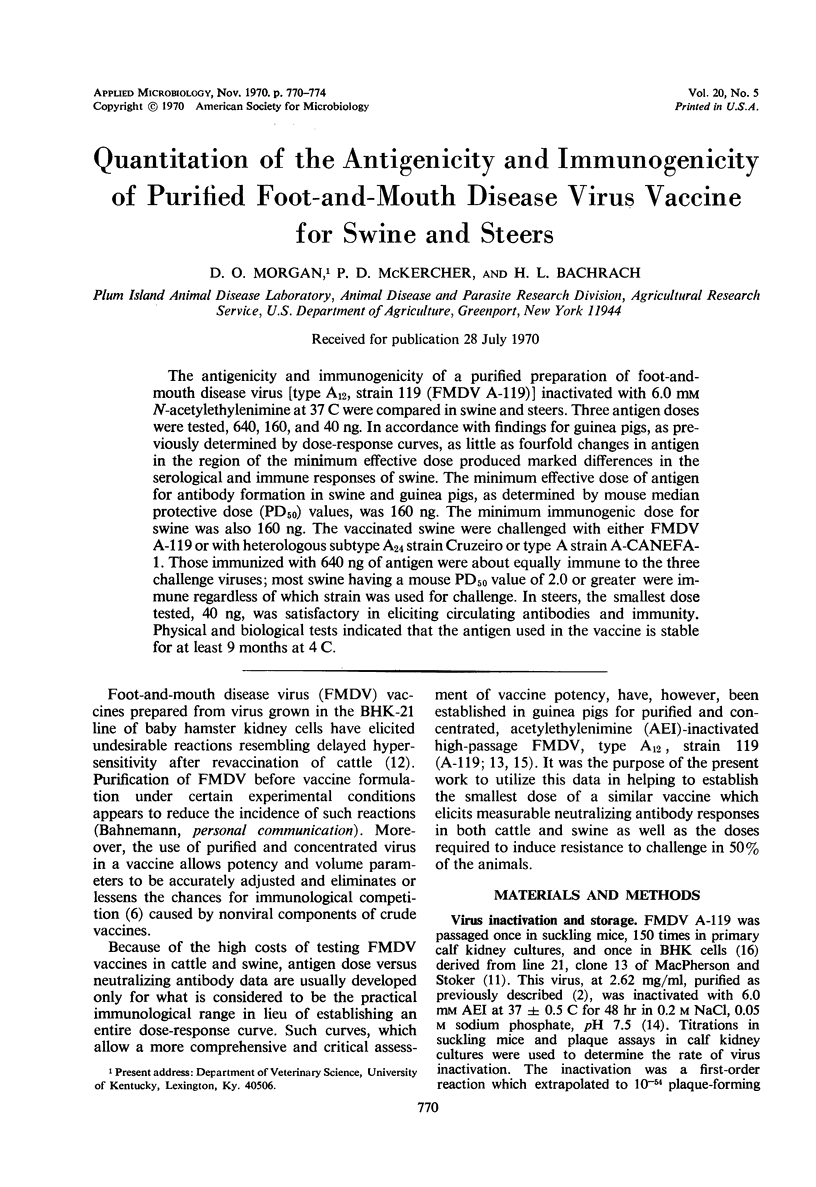
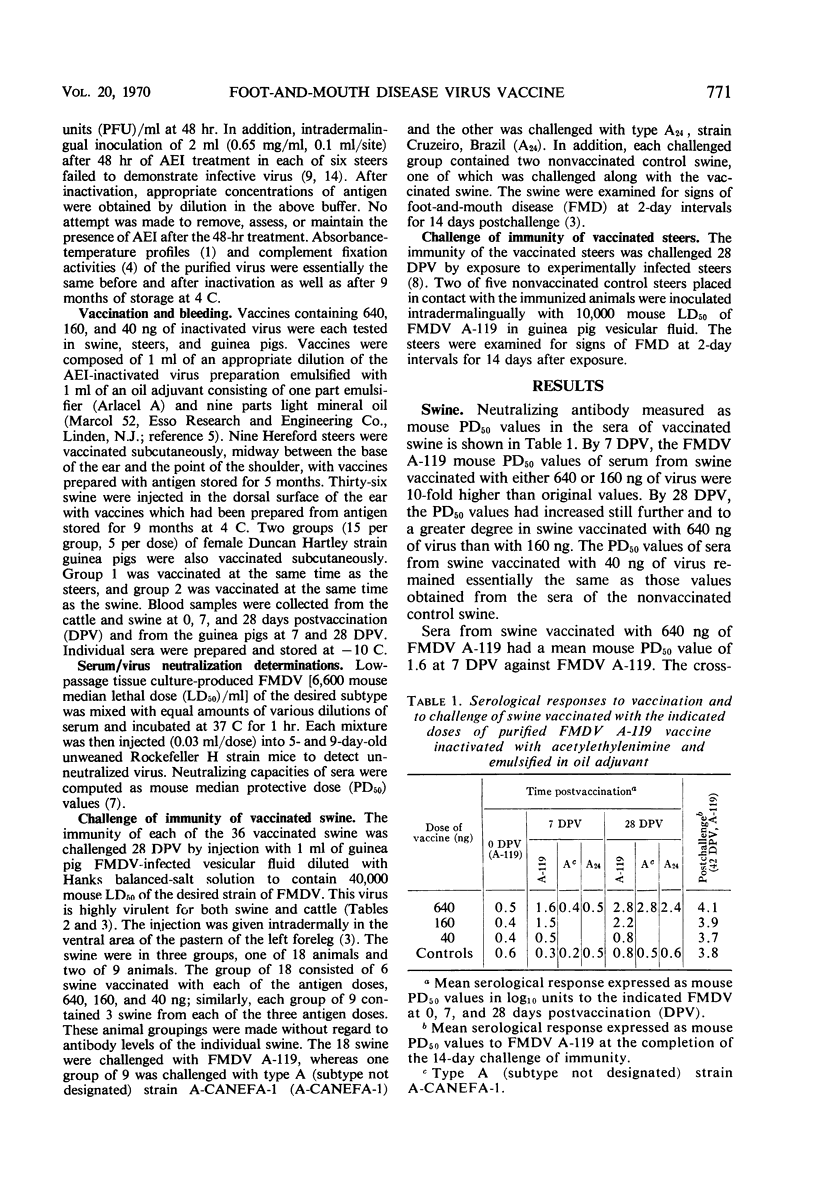
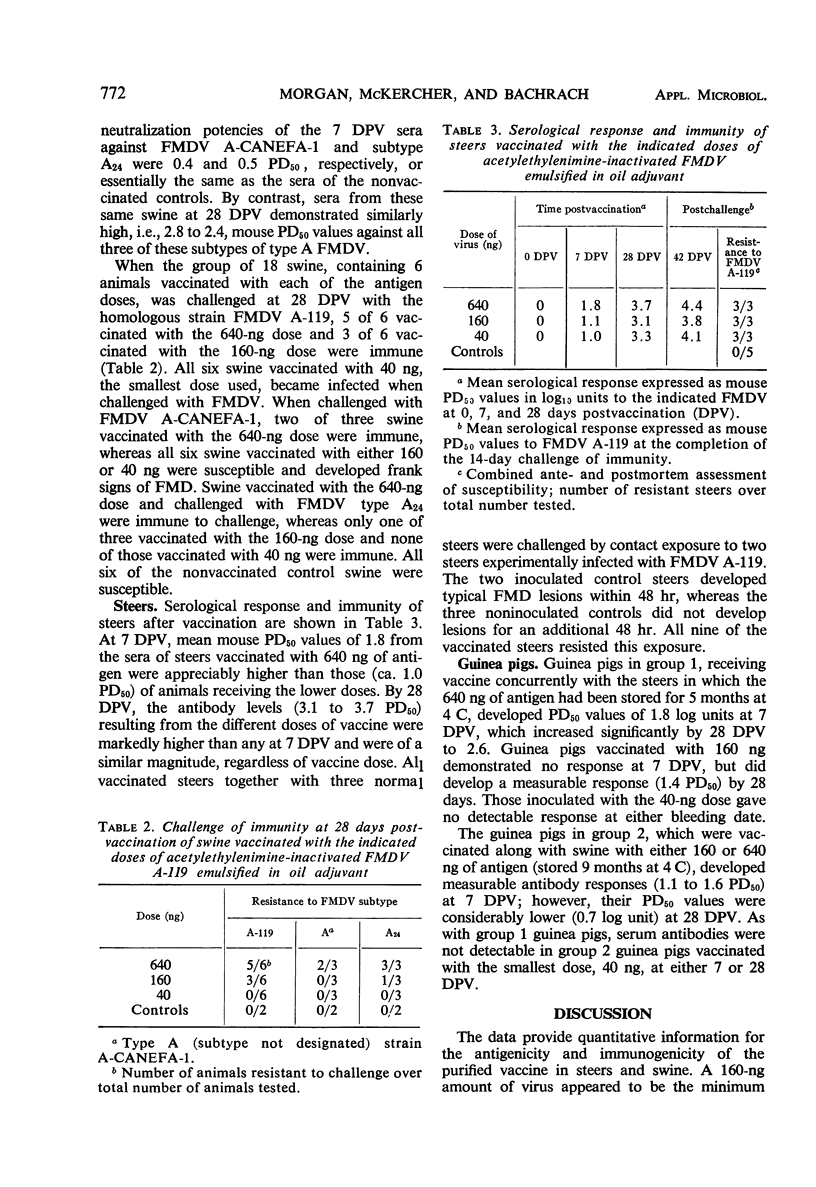
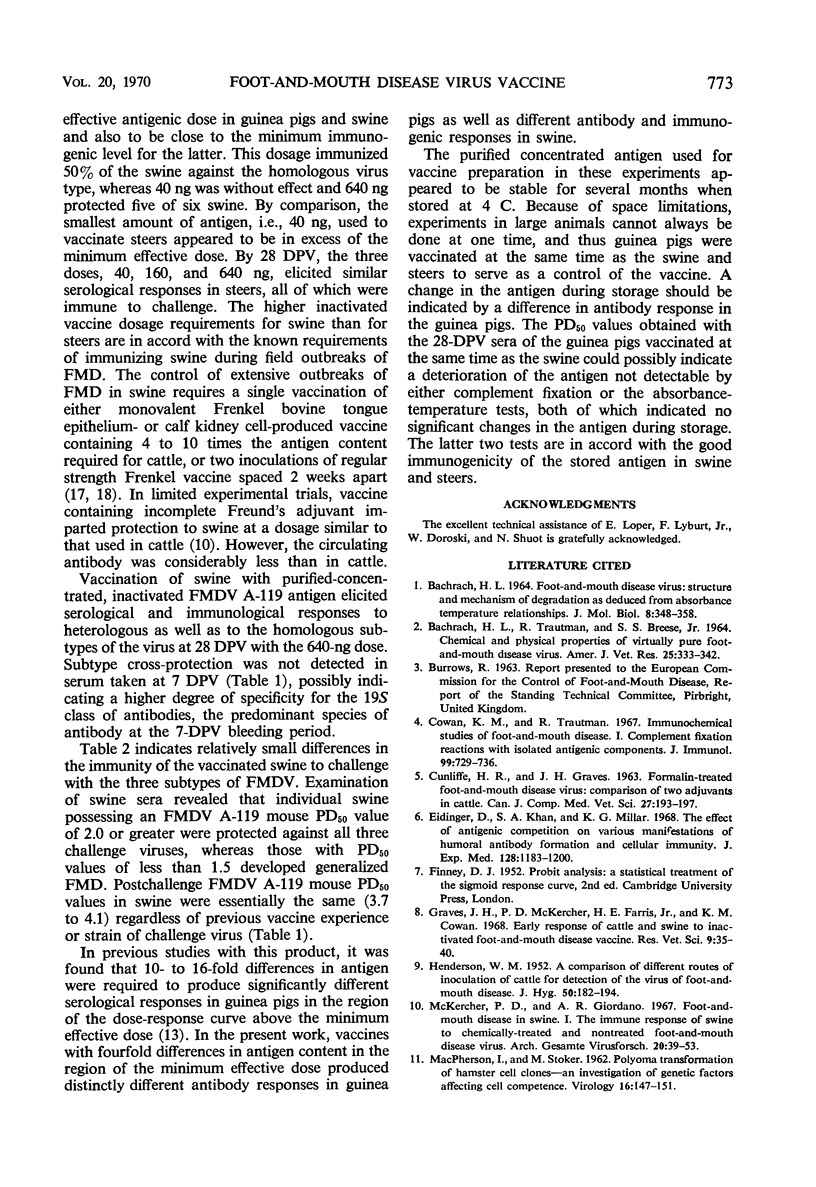
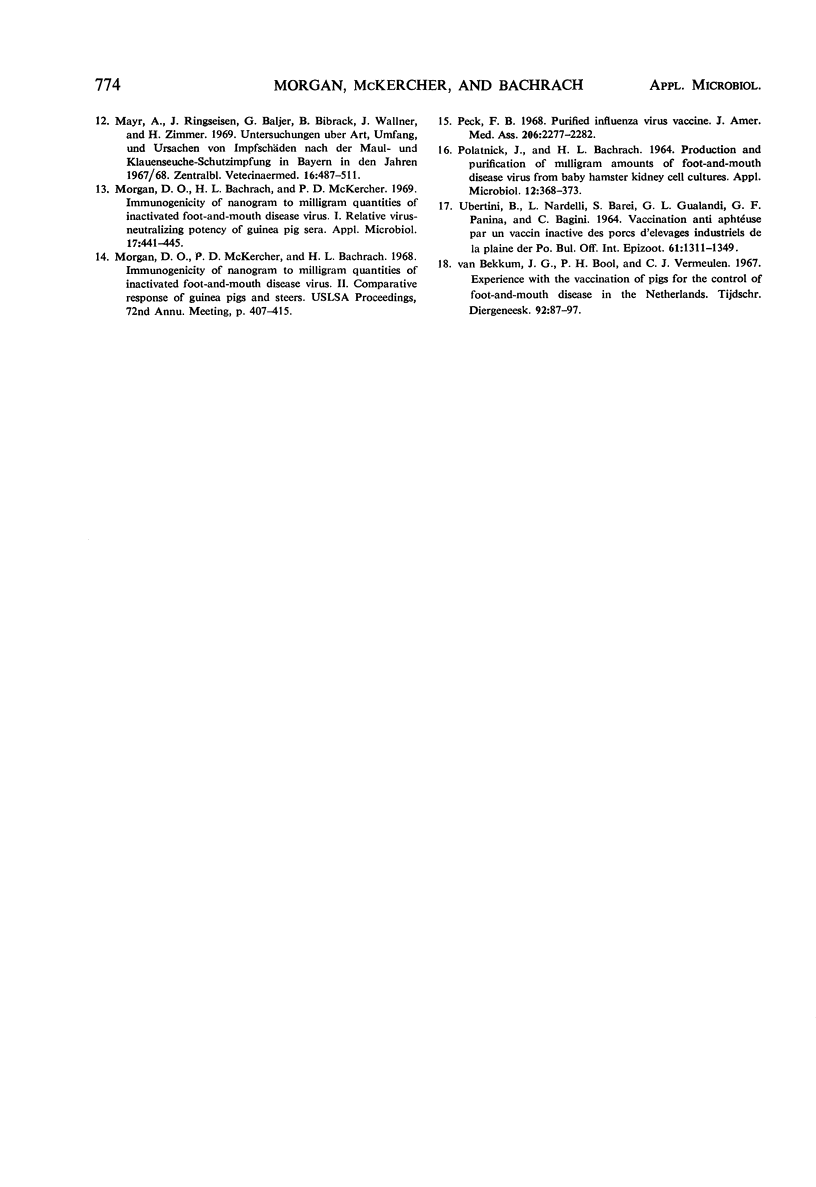
Selected References
These references are in PubMed. This may not be the complete list of references from this article.
- BACHRACH H. L. FOOT-AND-MOUTH DISEASE VIRUS: STRUCTURE AND MECHANISM OF DEGRADATION AS DEDUCED FROM ABSORBANCE-TEMPERATURE RELATIONSHIPS. J Mol Biol. 1964 Mar;8:348–358. doi: 10.1016/s0022-2836(64)80198-4. [DOI] [PubMed] [Google Scholar]
- BACHRACH H. L., TRAUTMAN R., BREESE S. S., Jr CHEMICAL PHYSICAL PROPERTIES OF VIRTUALLY PURE FOOT-AND-MOUTH DISEASE VIRUS. Am J Vet Res. 1964 Mar;25:333–342. [PubMed] [Google Scholar]
- Cowan K. M., Trautman R. Immunochemical studies of foot and mouth disease. I. Complement fixation reactions with isolated antigenic components. J Immunol. 1967 Oct;99(4):729–736. [PubMed] [Google Scholar]
- Cunliffe H. R., Graves J. H. Formalin-Treated Foot-and-Mouth Disease Virus: Comparison of Two Adjuvants in Cattle. Can J Comp Med Vet Sci. 1963 Aug;27(8):193–197. [PMC free article] [PubMed] [Google Scholar]
- Eidinger D., Khan S. A., Millar K. G. The effect of antigenic competition on various manifestations of humoral antibody formation and cellular immunity. J Exp Med. 1968 Nov 1;128(5):1183–1200. doi: 10.1084/jem.128.5.1183. [DOI] [PMC free article] [PubMed] [Google Scholar]
- Graves J. H., McKercher P. D., Farris H. E., Jr, Cowan K. M. Early response of cattle and swine to inactivated foot-and-mouth disease vaccine. Res Vet Sci. 1968 Jan;9(1):35–40. [PubMed] [Google Scholar]
- HENDERSON W. M. A comparison of different routes of inoculation of cattle for detection of the virus of foot-and-mouth disease. J Hyg (Lond) 1952 Jun;50(2):182–194. doi: 10.1017/s0022172400019537. [DOI] [PMC free article] [PubMed] [Google Scholar]
- MACPHERSON I., STOKER M. Polyoma transformation of hamster cell clones--an investigation of genetic factors affecting cell competence. Virology. 1962 Feb;16:147–151. doi: 10.1016/0042-6822(62)90290-8. [DOI] [PubMed] [Google Scholar]
- Mayr A., Ringseisen J., Baljer G., Bibrack B., Wallner J., Zimmer H. Untersuchungen über Art, Umfang und Uraschen von Impfschäden nach der Maul- und Klauenseuche-Schutzimpfung in Bayern in den Jahren 1967-68. Zentralbl Veterinarmed B. 1969 Aug 6;16(6):488–511. [PubMed] [Google Scholar]
- McKercher P. D., Giordano A. R. Foot-and-mouth disease in swine. I. The immune response of swine of chemically-treated and non-treated foot-and-mouth disease virus. Arch Gesamte Virusforsch. 1967;20(1):39–53. doi: 10.1007/BF01245768. [DOI] [PubMed] [Google Scholar]
- Morgan D. O., Bachrach H. L., McKercher P. D. Immunogenicity of namogram to milligram quantities of inactivated foot-and-mouth disease virus. I. Relative virus-neutralizing potency of guinea pig sera. Appl Microbiol. 1969 Mar;17(3):441–445. doi: 10.1128/am.17.3.441-445.1969. [DOI] [PMC free article] [PubMed] [Google Scholar]
- Morgan D. O., McKercher P. D., Bachrach H. L. Immunogenicity of nanogram to milligram quantities of inactivated foot-and-mouth disease virus. II. Comparative response of guinea pigs and steers. Proc Annu Meet U S Anim Health Assoc. 1968;72:407–415. [PubMed] [Google Scholar]
- POLATNICK J., BACHRACH H. L. PRODUCTION AND PURIFICATION OF MILLIGRAM AMOUNTS OF FOOT-AND-MOUTH DISEASE VIRUS FROM BABY HAMSTER KIDNEY CELL CULTURES. Appl Microbiol. 1964 Jul;12:368–373. doi: 10.1128/am.12.4.368-373.1964. [DOI] [PMC free article] [PubMed] [Google Scholar]
- Peck F. B., Jr Purified influenza virus vaccine. A study of viral reactivity and antigenicity. JAMA. 1968 Dec 2;206(10):2277–2282. [PubMed] [Google Scholar]


